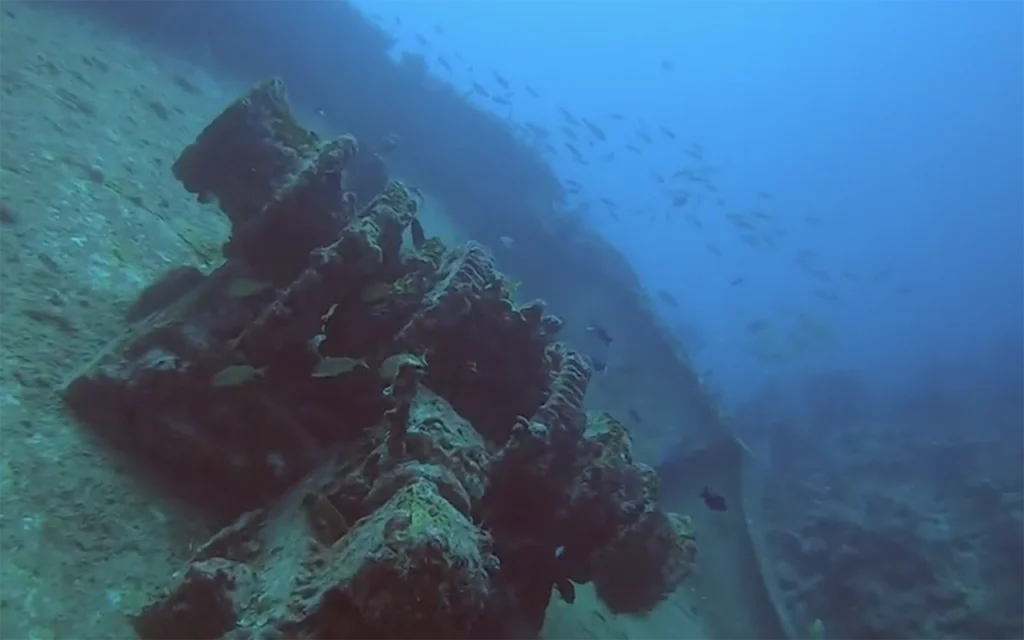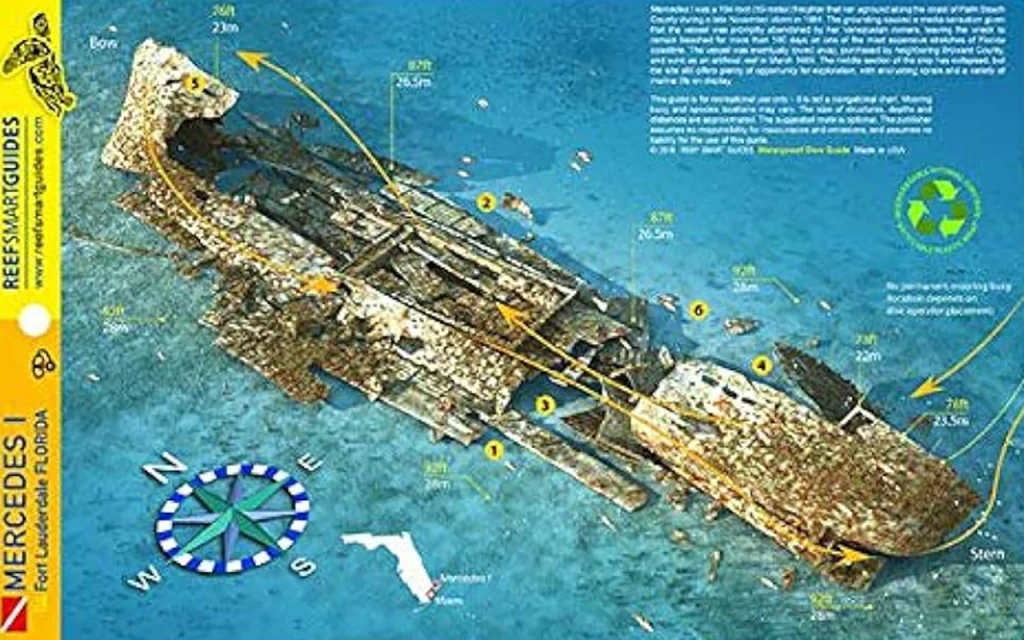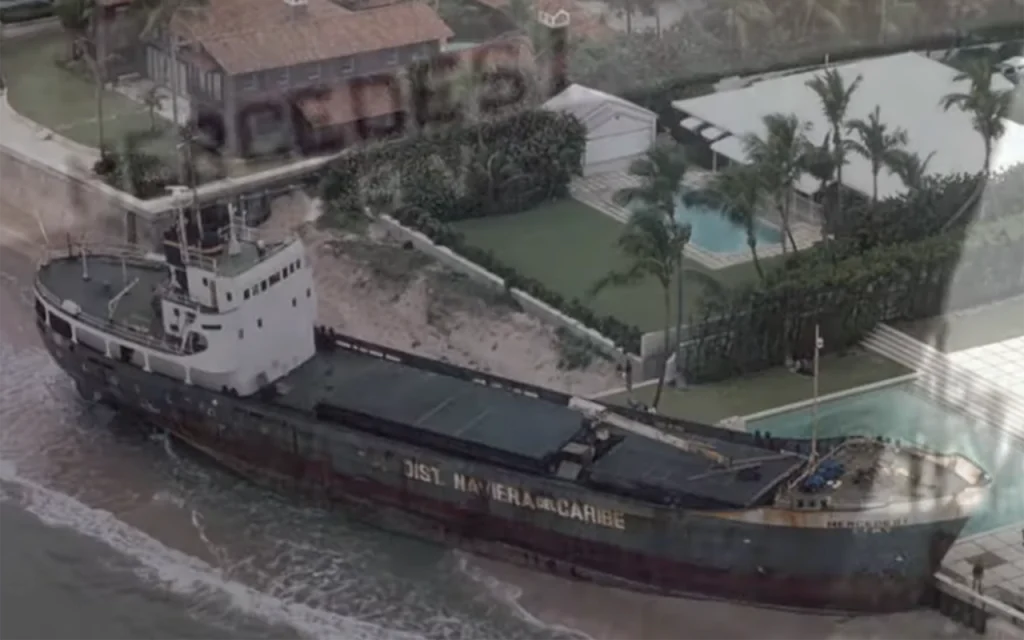Table of Contents

The Mercedes I is a popular dive site with an interesting modern history, it lacks the historical significance, treasure, and archaeological value of Florida’s older shipwrecks from the colonial era. However, its accessibility and relatively intact structure make it a unique and enjoyable dive experience in its own right.
Article at a Glance
- Historical Journey: Originally built in 1951 as the Jacob Rusch, the ship underwent several name changes before becoming the Mercedes I, serving as a coastal freighter.
- Famous Grounding: In November 1984, the ship gained notoriety when it ran aground on a Palm Beach socialite’s property, leading to a media frenzy.
- Sinking as an Artificial Reef: The Mercedes I was intentionally sunk on March 30, 1985, off Fort Lauderdale to create an artificial reef, attracting marine life and divers alike.
- Current Condition: The wreck lies at a depth of 97 feet (29.5 meters) and has suffered significant storm damage, resulting in a twisted structure with large gaping holes.
- Diverse Marine Ecosystem: The wreck has become a thriving habitat for various marine species, including barracuda and lobster, making it a popular dive site.
- Diving Experience: The site offers advanced diving opportunities with average visibility of 20 meters (65 feet), but divers should be cautious of potential entanglement and unstable structures.
- Accessibility: Several local dive shops in Fort Lauderdale provide trips to the Mercedes I, allowing divers to explore this unique underwater site.
Shipwreck Location Coordinates and Depth
Depth
- The wreck has a relief (height off the bottom) of 30 feet (9 meters).
- The depth range for diving this wreck is 60-100 feet.
Location Coordinates
- Latitude: 26° 09.370′ N
- Longitude: 80° 04.513′ W

What Do Scuba Divers Say About This Ship
Dive Site Description
Divers describe the Mercedes I as:
- A 194-foot long freighter with a 30.6-foot beam, lying in 97 feet of water off Fort Lauderdale, Florida.
- The wreckage is twisted into two pieces with large gaping holes.
- The midship section has collapsed, except for some visible gasoline truck bodies.
- Penetration of the wreck is considered tricky, with warnings about potential entanglement.
Diving Experience
Despite the damage to the wreckage, divers report that it is still a “great fish haven”.The wreck is suitable for:
- Underwater photography
- Wreck diving
Divers note the following conditions:
- Limited current
- Visibility ranging from 10-30 meters, with an average of 20 meters
- Salt water environment
Marine Life
Divers can expect to see various marine life around the wreck, including:
- Barracuda
- Lobster
Historical Interest
Many divers are drawn to the Mercedes I not just for its underwater features, but also for its “colorful history”. The wreck gained fame when it ran aground on a Palm Beach socialite’s property in 1984, creating a media frenzy before it was eventually sunk as an artificial reef in 1985.
Diving Practicalities
- The wreck is accessible by boat, with a typical travel time of about 30 minutes.
- It’s considered suitable for underwater photography and wreck diving.
- Divers are advised to be careful of passing pleasure boats in the area.
What Kind of Marine Life Can Be Found on The Ship
Fish Species
- Barracuda: These predatory fish are frequently spotted around the wreck.
Crustaceans
- Lobster: The wreck provides excellent shelter for lobsters, making it a popular spot for divers to observe these crustaceans.
General Marine Ecosystem
While not specifically mentioned in the search results, shipwrecks like the Mercedes I typically become artificial reefs that support a diverse ecosystem. Divers often report seeing:
- Various reef fish species
- Coral and sponge growth on the wreck’s structure
- Occasional visits from larger pelagic species
Wreck as a Fish Haven
Despite the damage to the wreckage over the years, it is still described as a “great fish haven”. This suggests that the wreck continues to attract and support a variety of marine life, making it an interesting site for underwater photography and marine life observation.
Key Information
| Attribute | Details |
|---|---|
| Name | Mercedes I |
| Type | Freighter/Cargo Ship |
| Length | 194 feet (59 meters) |
| Beam | 30.6 feet (9.33 meters) |
| Depth | 97 feet (29.5 meters) |
| Location | Off Fort Lauderdale, Florida |
| Coordinates | 26° 09.370′ N, 80° 04.513′ W |
| Date Sunk | March 30, 1985 |
| Purpose | Artificial Reef |
| Original Build | 1951/1952 in Hamburg, Germany |
| Original Name | Jacob Rusch |
| Current Condition | Broken into two pieces, collapsed midship |
| Notable Features | Visible gasoline truck bodies, large gaping holes |
| Marine Life | Barracuda, lobster, various reef fish |
| Dive Difficulty | Advanced (due to depth and structure) |
| Visibility | Average 20 meters (65 feet) |
| Hazards | Potential entanglement, unstable structure |
What Makes The Mercedes I shipwreck a Unique Diving Experience
Historical Significance
The Mercedes I has a colorful history that adds intrigue to the dive:
- Originally built in 1951 as a coastal freighter named Jacob Rusch
- Gained international fame in 1984 when it ran aground on a Palm Beach socialite’s property, creating a media frenzy
- Sunk as an artificial reef on March 30, 1985 off the coast of Fort Lauderdale
Wreck Structure
The current state of the wreck provides an interesting exploration:
- 194-foot long freighter with a 30.6-foot beam
- Twisted into two separate pieces due to hurricane damage over the years
- Large gaping holes and a collapsed midship section
- Visible gasoline truck bodies in some areas
- Offers opportunities for brief penetration dives, though caution is advised due to entanglement risks
Marine Ecosystem
The wreck has become a thriving artificial reef:
- Described as a “great fish haven”
- Home to various marine life, including barracuda and lobsters
- Supports coral and sponge growth
Diving Conditions
- Lies at a maximum depth of 97 feet (29.5 meters)
- Has a relief (height off the bottom) of 30 feet (9 meters)
- Generally experiences limited current
- Offers visibility ranging from 10-30 meters, with an average of 20 meters
Location and Accessibility
- Located off the coast of Fort Lauderdale, Florida
- Part of a cluster of wrecks in the area, with other sites nearby
- Accessible by boat, typically a 30-minute trip
Photography Opportunities
The combination of the wreck’s structure, marine life, and generally good visibility makes it an excellent site for underwater photography.
How Does The Mercedes I Compare to Other Shipwrecks in Florida
Historical Significance
Unlike many of Florida’s older shipwrecks, the Mercedes I is a relatively modern vessel:
- Sunk in 1985 as an artificial reef, compared to historic wrecks from the colonial era
- Lacks the treasure and historical artifacts found in Spanish galleons or colonial-era ships
Origin and Purpose
The Mercedes I has a unique backstory:
- Originally a coastal freighter, not a treasure ship or military vessel
- Gained fame from running aground on a socialite’s property before being sunk intentionally
- Serves as an artificial reef rather than being an accidental wreck
Accessibility and Condition
Compared to older wrecks, the Mercedes I offers:
- Relatively intact structure, despite storm damage over the years
- Easier accessibility at 97 feet depth, compared to some deep-water historical wrecks
- Good visibility and diving conditions, making it popular for recreational divers
Marine Life
While the Mercedes I supports a thriving ecosystem, it differs from older wrecks:
- Younger artificial reef compared to centuries-old wrecks that have become established ecosystems
- Lacks the historical marine growth and coral formations found on much older wrecks
Archaeological Value
The Mercedes I offers less archaeological significance:
- No historical artifacts or treasures to recover
- Limited research value compared to colonial-era wrecks that provide insights into historical trade and naval technology
What is The Full History of This Ship
Early History
- Originally built in 1951 or 1952 by Herbert Ranke’s shipyard in Cranz-Neuenfelde (Hamburg), Germany
- Initially named Jacob Rusch and operated as a coastal freighter
- Renamed several times:
- 1963: Sold to Otto Nagel of Lübeck and renamed Rosita Maria
- 1968: Sold to Heinz Georg Vöge of Hechthausen and renamed Rita Vöge
- 1976: Sold to a Panamanian company and given its final name Mercedes I
Later Operations
- Eventually sold to a Venezuelan shipping firm, Distribudora Navieras del Caribe S.R.L.
- Operated as a 194-foot long freighter with a 30.6-foot beam
Famous Grounding Incident
- November 23, 1984: Broke from its mooring during a storm and ran aground in Palm Beach, Florida
- Crashed into the seawall of Palm Beach socialite Mollie Wilmot’s home, nearly going into her pool
- The 12-man crew safely evacuated, and the vessel’s owner abandoned the ship
- The grounding created a media frenzy due to its location on one of the most expensive stretches of beach
Salvage and Preparation for Sinking
- March 6, 1985: After several unsuccessful attempts over three months, salvage crew from Don Jon Marine Company managed to pull the ship off the beach during a strong lunar high tide
- The salvage operation cost $223,000 from a Federal fund
- The ship was then purchased for $29,000 by the Broward County Environmental Control Board
- Prepared for sinking as an artificial reef
Sinking as an Artificial Reef
- March 30, 1985: Sunk off the coast of Fort Lauderdale to create an artificial reef
- 20,000 spectators watched the sinking, including Mollie Wilmot from the Goodyear Blimp
- The ship was detonated to sink it to its final resting place
Current State
- Lies at a maximum depth of 97 feet (29.5 meters) off the coast of Fort Lauderdale
- Over the years, storms have significantly impacted the once-intact structure:
- Large sections have collapsed
- Portions of the hull have been scattered in the surrounding sand
- Despite the damage, it remains a popular dive site and “great fish haven”
- Part of a cluster of wrecks in the area, with other wrecks like the Jay Scutti, Tracy, and Merci Jesus located nearby

What Historical Features Can Still Be Identified on the Mercedes I Wreck
Ship Structure
- The wreck is twisted into two separate pieces, likely due to storm damage over the years.
- Large gaping holes are visible in the structure.
- The midship section has collapsed, though some parts remain intact.
Specific Identifiable Features
- Gasoline truck bodies: These are still visible in the collapsed midship section.
- Hull sections: Portions of the hull have been scattered in the surrounding sand due to storm damage over time.
Dimensions
- The wreck’s original dimensions can still be observed:
- Length: 194 feet (59 meters)
- Beam: 30.6 feet (9.33 meters)
Depth and Position
- The wreck lies at a maximum depth of 97 feet (29.5 meters).
- It has a relief (height off the bottom) of 30 feet (9 meters).
- The wreck rests upright on the seafloor.
Historical Context
While not physical features, divers can appreciate:
- The wreck’s position as an artificial reef, intentionally sunk in 1985.
- Its location off the coast of Fort Lauderdale, Florida.
What Safety Measures Are in Place for Divers Visiting the Mercedes I
- Depth awareness: The wreck lies at a maximum depth of 97 feet (29.5 meters), with a relief of 30 feet (9 meters) off the bottom. Divers need to be aware of these depths and plan their dive profiles accordingly.
- Penetration caution: The wreck description notes that “Penetration is tricky, watch out for entanglement.” This warns divers to be extremely cautious if attempting to enter the wreck, due to potential hazards inside.
- Structural damage awareness: Over the years, storms have significantly impacted the wreck, causing large sections to collapse and portions of the hull to scatter. Divers should be aware of the unstable nature of the structure.
- Boat traffic warning: The dive site information specifically warns that “Pleasure boats can pass at Mercedes Wreck. Be careful.” This alerts divers to be cautious of boat traffic, especially during ascent and descent.
- Recommended training: While not explicitly stated for this wreck, many dive sites have recommended minimum training levels for wreck diving.
- Dive planning: The site provides important information like average visibility (20 meters), current conditions (limited), and marine life presence, allowing divers to plan their dives appropriately.
- Boat dive protocols: As this is a boat dive, standard safety measures for boat diving would apply, such as having a dive flag, proper entry and exit procedures, and surface support.
- Buddy system: As with all diving, the buddy system would be in effect for added safety.
Dive Shops That Provide Diving Trips to This Shipwreck
- Sea Experience
- Located at 801 Seabreeze Blvd, Fort Lauderdale, FL 33316
- Phone: (954) 770-3483
- Website: http://www.seaxp.com/
- Offers scuba diving trips and regular classes
- American Dream Dive Charters
- Located behind the Hilton on 17th Avenue, just south of downtown Fort Lauderdale
- Operates a Newton Dive Boat
- South Florida Diving Headquarters
- While not explicitly mentioned as offering trips to Mercedes I, this company provides information about the wreck and likely offers dive trips to the site
South Florida Wrecks
- SS Copenhagen
- Captain Dan Wreck
- SS Arratoon
- Queen of Nassau
- USS Mohawk
- MV Castor
- Esso Bonaire III
- St. Jacques
- The Gilbert Sea
- Shasha Boekanier
- Thozina
- The Orion
- The DEMA Trader
- Ancient Mariner
- The Amaryllis
- The Ande
- USS Hydro Atlantic
- Zion Train
- Mercedes I
- Half Moon
- The Danny
- The Ultra Freeze
- The Doc DeMilly
- Jay Scutti
- The Tracy
- Sea Emperor
- Jim Atria
- Merci Jesus
- Princess Britney





